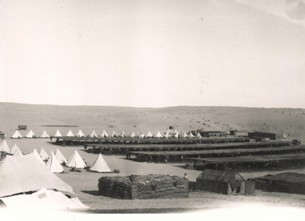I usually write about art in the visual art sense, but life as an art form extends far beyond the visual arts. I have just had such an impressive example of other ways of perfecting a way of living - and survival - that I cannot resist writing about it.
In searching for some photographs that my grandfather, Frank Anderson, took in the immediate aftermath of the 1923 earthquake in Yokohama, Japan, through which he had just survived, I happened on the small leatherbound diary that he had kept in 1915.
A Western Australian educated in Switzerland and England, he had immediately joined up as the First World War broke out. He was in B Squadron of the 10th Light Horse, the most famous and heroic of the Australian regiments, and as 1915 began, he boarded the Mashobra, transporting him and his fellow soldiers and their horses by ship to the war raging in Europe.
Along with the rest of the 10th Light Horse, he trained in Cairo and Heliopolis, enduring sandstorms and caring for the horses as they waited for orders to move to the front in the fight against the Turks, in the now-hallowed area of Gallipoli in the Dardenelles.
On 15th May, he and his fellow Australians and New Zealanders left Alexandria for the front. By 21st May, they were ashore at Walker's Ridge, in the trenches at Snipers Corner, digging themselves into the side of a cliff under deadly fire. Frank Anderson was charged with doing sketches of the Anzac trenches, and in the evening, "took a party of officers up a gully to show them three corpses. A shrapnel burst right amongst us wounding Olden and tearing Craig's britches to pieces. A ricochet caught me on shoulders but only bruised. Quite exciting."
Sapping, issuing stores, coping with acute water shortages and seeing fellow soldiers wounded or killed left and right were the new norm. A 3 a.m. stand to arms began the day on 27th May, followed by occupation of the trenches at 11 a.m. "The Turkish trenches are only 30 yards from us and (they) drop hand grenades into our trenches. Found it very hard job to keep awake . Occasional firing but with the exception of blowing one of our saps in, things were quiet. We were in Quinn's Post, the worst trench of all."
After a days of snipers taking out another 18 men, Saturday, 29th May, began at "3.15 a.m.(when) we were startled by a tremendous explosion and were half buried in dirt. The Turks had sapped and blown no. 3 Quinn's up and they immediately rushed the whole of our centre. The awful din that followed I will never forget. Shells, hand grenades and rifle fire made an absolute hell. The Adjutant sent me with 12 men to help no. 5 post. On our way up, Sydney was hit in the elbow. When I got into the firing trench, found that the Turks had captured no. 4 trench and were enfilading us with bombs. There were a lot of wounded but the stretcher bearers were doing good work.
"The Turks come rush after rush to try to get our trench but we kept a murderous fire going and they got no further than our parapet. Young Jackson kept very cool and turned up trumps. Several men were kept busy bringing up fresh rifles as they soon overheated and jammed. A lot of harm was saved by throwing our overcoats over the bombs as they came into the trenches, but on two occasions I was almost buried with dirt. Pat's part got it very hot too and he was hit in the arm with a bit of bomb and I believe has gone back to Cairo....About 5 a.m. our men stormed no. 4 trench and after a hard tussle, drove the Turks out again. Almost immediately after, the enemy rushed our trench again, but none got in. One Turk grabbed my bayonet and in some way got it off the rifle, but got my bullet through his chest and was soon dead. From then on things got quiet and we were relieved at 3 p.m. Our casualties were 16 wounded in our squadron."
(Part 2 of this diary account of Frank Anderson's war experiences in Gallipoli, during 1915, continue in Part 2, the next post in this blog.)





